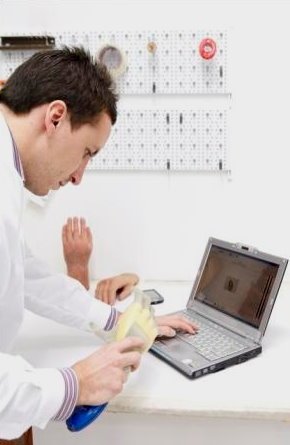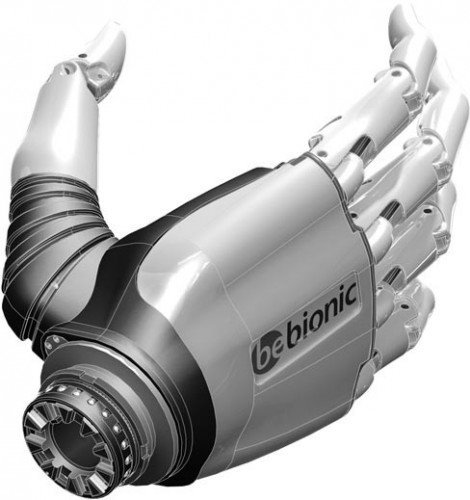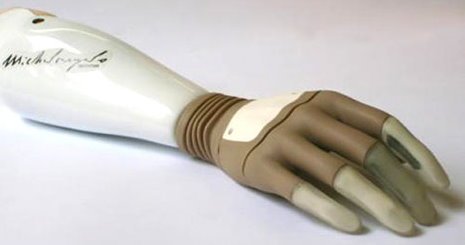In forearm amputations we mainly apply cosmetic, mechanical or muscle-electric prostheses. By applying muscle-electric prostheses we predict a more valid function, with greater adhesive strength and optimum aesthetics, bearing the cost of greater weight and construction expenses. Electrodes, placed along the abutment receive the electric potential difference, which is generated during muscle contraction, thereby transmitting an electric signal to achieve several of the physiological moves executed by the healthy limb. The prostheses operate with motors and rechargeable lithium batteries.

The operation of the muscle-electric prostheses is based on the energy of the embedded accumulator and the guidance from signals captured by appropriate electrodes on the muscle surface of the abutment or the limb presenting congenital deficiency and requires prosthetic restoration. This system supplies the micro-motors, which in turn activate the prosthesis.
The muscle-electronic control is referred to the process needed to identify the muscle group that feeds exclusively the muscle-electric prosthesis. In order to exploit the capabilities of a muscle-electric control system, we initially identify the points with the strongest external signal during the contractions of the abutment’s muscles. This is achieved using surface electrodes connected with a specific methodology, which provides us the instructions for the electronic signal amplification through a computer. It is true that the patients consider this procedure particularly interesting, because they are introduced directly and practically the idea of muscle-electronic control, being able to actively participate in the optimization of the outcome
When we have identified the most suitable points and have performed the necessary arrangements, we temporarily stabilize the electrodes on the limb and connect them to the computer or in a real muscle-electronic hand on the educational table. Our patient then has the opportunity to do preliminary training by testing his muscles either with the graphic model of the hand in a special computer program, or with the actual muscle-electric hand.
For the success of the muscle-electric control, we should obtain signals both strong and distinctive, in order to achieve the independent activation of the fingers and the wrist mechanism. When the above stages have been achieved, we are able to move forward in constructing the prosthesis.
Bebionic (βιονικό άκρο)
To Bebionic έιναι μία έξυπνη πρόθεση σχεδιασμένη για να προσαρμόζεται με ευκολία και να ανταποκρίνεται με άνεση στις καθημερινές εργσίες. Επρόκειτω για μια μυοηλεκτρονική πρόθεση πολύ ελαφριά, με ενσωματομένους αρθρωτούς κινητήρες και τεράστιο έυρος κινήσεων.
Η ρομποτική αυτή τεχνολογία το καθιστά πρωτοπόρο όσον ααφορά την λειτουργικότητα του καθώς επίσης κα την άριστη αισθητική που επιτυγχάνεται χαρη στο διακοσμητικό γάντι σιλικονης που καλύπτει την πρόθεση στις αποχρώσεις του υγειούς μέλους.

I-limb Hand (Touch Bionics)
It is the first muscle-electronic hand having an independent finger power feeding, which offers independent finger movement to the patient. The “I-limb” Hand has already been successfully installed in a significant number of patients in America and Europe and lately in Greece through our company. The specific prosthesis provides the users with the ability to perform skillful movements, increasing the levels of functionality than any other muscle-electronic hand.
Michelangelo (Otto-Bock)
The Michelangelo by the Otto Bock House is the first bionic limb of the German company, which has multiple functions, similar to those of a normal limb. It is the only artificial limb providing the ability of active flexion/extension of the wrist, while setting new standards of functionality.
Finally, in the field of rehabilitation in cases of hand amputations, we prefer the prosthetic silicone constructions for a highly aesthetic outcome.

This technical approach enables us to create models for individual fingers or even the whole hand, depending on the occasion. The configuration of the structure is based on a properly prepared mold from the affected area and a copy of the healthy side, recording the anatomical features of the healthy limb.

